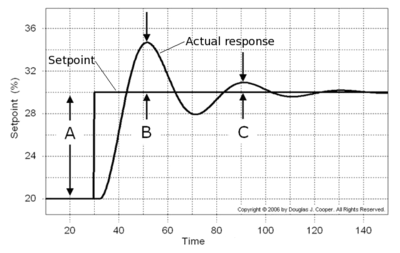Difference between revisions of "Setpoint signal"
From Granite Devices Knowledge Wiki
| [checked revision] | [checked revision] |
m (Text replacement - "\[\[([A-Z]{2,3})\]\]" to "{{param|$1}}") |
m (Text replacement - "{{param|PWM}}" to "PWM") |
||
| Line 9: | Line 9: | ||
* [[Analog setpoint]] signal | * [[Analog setpoint]] signal | ||
* [[Pulse and direction]] signals | * [[Pulse and direction]] signals | ||
| − | * | + | * [[PWM]] signal |
* Serial communication command | * Serial communication command | ||
| Line 16: | Line 16: | ||
{| class="wikitable" | {| class="wikitable" | ||
|- | |- | ||
| − | ! !! [[Analog setpoint|Analog]] !! [[Pulse and direction|Pulse & dir]] or [[Quadrature]] !! | + | ! !! [[Analog setpoint|Analog]] !! [[Pulse and direction|Pulse & dir]] or [[Quadrature]] !! [[PWM]] !! Serial / Network |
|- | |- | ||
| Scale & range || Absolute (limited) || Incremental (infinite) || Absolute (limited) || | | Scale & range || Absolute (limited) || Incremental (infinite) || Absolute (limited) || | ||
Latest revision as of 19:59, 28 August 2015
Setpoint (a.k.a reference) signal is a signal that will be used as target value in control systems. Typical occurrencies of setpoint signals in GD products are:
- Position setpoint
- Velocity setpoint
- Torque setpoint
I.e. position setpoint value may be "1234" which could mean a target position of 1234 mm in some linear actuator. Or torque setpoint of 5.0 could mean that motor is asked to produce 5 Nm torque.
Physical setpoint signal types[edit | edit source]
Setpont signals may have several representations in real world such as:
- Analog setpoint signal
- Pulse and direction signals
- PWM signal
- Serial communication command
In these cases there will be a conversion between input and output units. For example when using +/-10V as velocity setpoint, the relation between input to output types could be 1 Volt per 100 rpm (or any other scale).
Setpoint signal characteristics[edit | edit source]
| Analog | Pulse & dir or Quadrature | PWM | Serial / Network | |
|---|---|---|---|---|
| Scale & range | Absolute (limited) | Incremental (infinite) | Absolute (limited) |
|
| Setpoint uses in motion control | Torque, velocity | Position, velocity | Torque, velocity | Position, torque, velocity, parameters |
| Pros |
|
|
|
|
| Cons |
|
|
|
|
